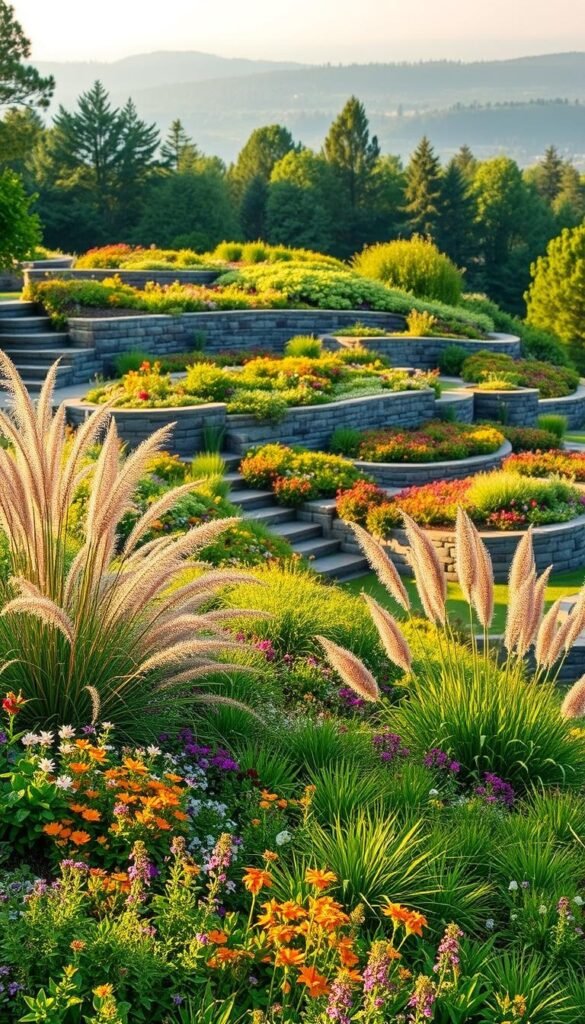If your property has a natural incline, you might feel stuck between loving the views and dreading the upkeep. A hillside landscape offers unique opportunities, but uneven terrain can lead to soil erosion, water runoff, and tricky maintenance. The good news? With smart planning, your slope can become a standout feature rather than a headache.
Steep areas actually provide built-in advantages. Their natural contours create dramatic visual layers, while gravity helps with drainage—if managed properly. You’ll discover how to work with your land’s shape instead of fighting it, using methods that prevent erosion and make care easier.
This guide covers two proven approaches: creating flat planting zones through terracing and designing rock features that stabilize the ground. Both options add structure while letting you grow vibrant plants suited to your climate. We’ll break down practical steps to transform your space into a low-maintenance retreat that turns heads.
Ready to reimagine your hillside? Let’s explore how to turn challenges into design triumphs that boost curb appeal and outdoor enjoyment.
Understanding Your Sloped Yard’s Potential
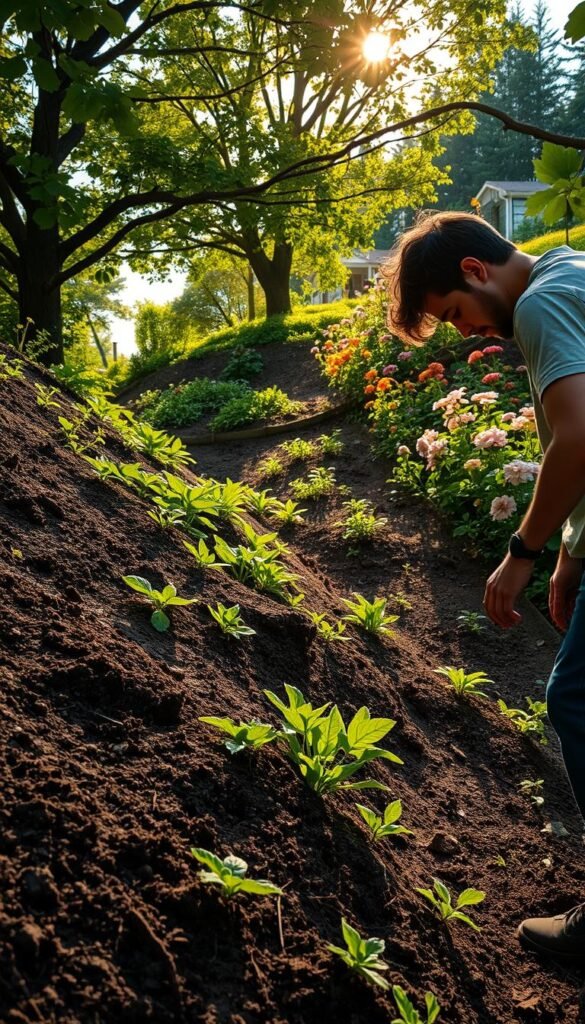
Unlocking your slope’s potential begins with a thorough evaluation of its unique conditions. Think of your hillside as a puzzle where slope grade, soil composition, and natural drainage patterns form the pieces. Getting this right ensures your design works with the land rather than against it.
Assessing Slope, Soil, and Drainage Conditions
Start by measuring your incline’s steepness. A slight slope (under 10%) might only need strategic planting, while steeper grades require terraces or retaining walls. Grab a handful of dirt—sandy soils drain fast but erode easily, while clay holds water longer. Testing helps you spot drainage issues before they become costly problems.
Watch how rainwater flows during storms. Areas with pooling water need better drainage solutions like French drains or dry creek beds. Remember: proper water management protects both plants and hardscaping from erosion damage.
Identifying Sun, Shade, and Microclimates
Track sunlight patterns across seasons. South-facing slopes bake in full sun, while north-facing areas stay cooler. Notice how rock surfaces radiate heat or how valleys trap moisture—these microclimates let you grow plants that wouldn’t thrive elsewhere.
Shady spots under trees work for ferns, while sun-drenched berms suit drought-tolerant species. Mapping these zones helps you match plants to their ideal growing conditions, reducing maintenance and boosting survival rates.
Flower Garden Inspiration for Sloped Yards: Terracing and Rock Garden Ideas
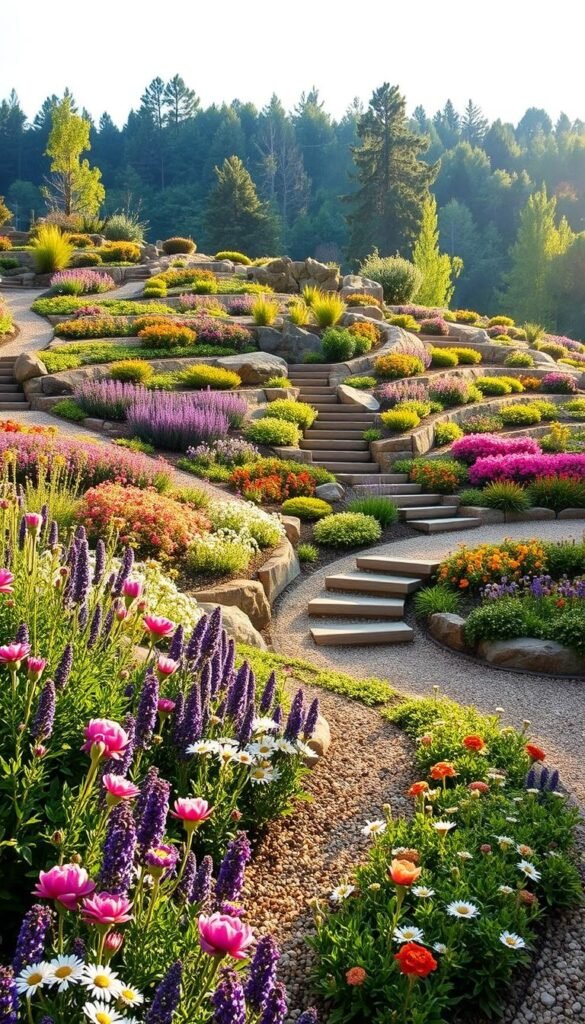
Transforming your slope into a living canvas begins with thoughtful preparation. Start by sketching rough zones on graph paper—mark existing trees, drainage patterns, and desired features. Local botanical gardens and Pinterest boards brim with creative solutions for angled spaces. One landscaper notes: “Successful slopes balance beauty with practicality—every path should tell a story while preventing mudslides.”
Mapping Functional Beauty
Prioritize safe access with switchback paths or stone steps. Wide terraces allow comfortable planting and maintenance. Consider how materials like native stone or decomposed granite complement your home’s style—a rustic cabin pairs well with irregular boulders, while modern homes shine with clean-lined concrete.
Mix bed types for visual diversity. Drought-tolerant succulents thrive on sunny berms, while ferns nestle into shaded ravines. Leave space between groupings for mature growth—crowded plants compete for nutrients on slopes.
Curating Nature’s Palette
Choose species that stabilize soil naturally. Deep-rooted shrubs like ceanothus anchor hillsides, while ornamental grasses sway gracefully in breezes. For year-round color:
- Spring: creeping phlox cascades over rocks
- Summer: lavender tolerates dry conditions
- Fall: sedum varieties offer fiery hues
Remember: your plant choices become living architecture. Layer textures and heights to guide the eye upward or across the incline. Pair flowering perennials with evergreen groundcovers to maintain structure during dormancy.
Incorporating Terracing and Retaining Walls
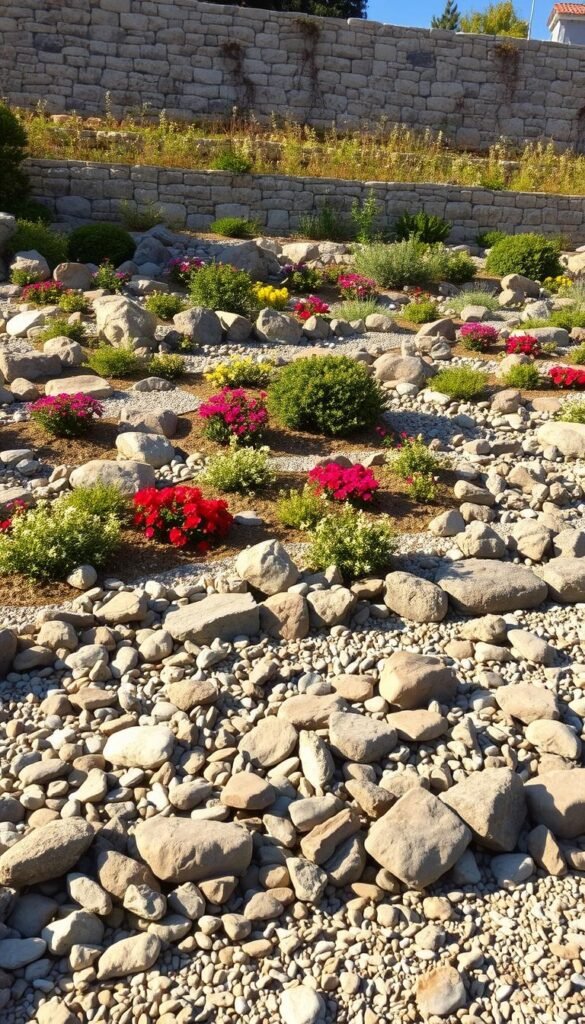
Taming a steep hillside becomes manageable when you strategically layer the terrain. Retaining walls act as natural stair steps, converting unstable slopes into organized planting zones. They prevent soil erosion while creating flat surfaces for flowers, herbs, or even cozy seating nooks.
Choosing the Right Materials and Scale
Material selection impacts both function and style. Natural stone blends seamlessly with surroundings but costs more. Concrete blocks offer affordability, while timber suits rustic themes. Pro tip: Match wall height to your slope’s steepness—4-foot walls work for moderate grades, while taller slopes need professional engineering.
Scale matters beyond measurements. Oversized boulders dwarf small yards, while petite stones get lost in expansive spaces. A landscape designer might suggest modular systems for complex layouts. Always include drainage gravel behind walls to prevent water buildup.
DIY Methods Versus Professional Installation
Handy homeowners can tackle short walls (under 3 feet) using interlocking blocks or timber. For these projects:
- Dig a 6-inch gravel base
- Use leveling sand for alignment
- Backfill with fast-draining soil
Steeper slopes or walls exceeding 4 feet require permits and experts. “Retaining walls fail when they lack proper footings,” notes Colorado-based contractor Mark Ellis. Professionals handle tricky soil types and integrate solutions like weep holes or geogrid reinforcement.
Phasing your project helps manage costs. Start with the most eroded area, then expand yearly. Local quarries often sell remnant stone at discounts—perfect for matching existing materials later.
Creating a Rock Garden that Anchors Your Landscape
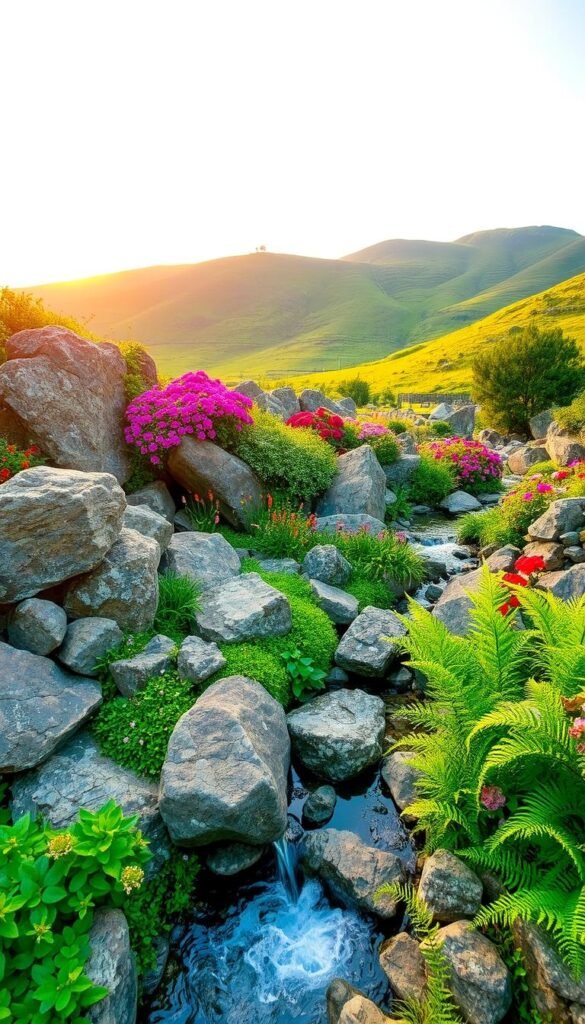
Rock gardens turn tricky slopes into stunning showcases of natural beauty. These low-maintenance spaces work with your land’s contours while solving erosion issues. Start by studying your slope’s natural flow—water runoff paths and existing rock formations often suggest ideal placements.
Selecting Rock Types and Placement Strategies
Choose 2-3 large anchor stones first—lighter-colored options keep the landscape feeling airy. Arrange them diagonally across the slope to mimic natural erosion patterns. Leave 12-18 inches between rocks for planting pockets. Fill gaps with smaller stones or gravel that complement your main features.
Local quarries offer stones matching your region’s geology. A designer tip: “Bury one-third of each rock’s height into the ground for stability and authenticity.” Mix angular and rounded shapes to create visual tension without chaos.
Integrating Water Features and Natural Elements
Your slope’s natural drainage makes adding water features easier. A cascading stream between rocks becomes a self-watering system for nearby plants. For dry climates, consider faux-dry creek beds using smooth river rocks—they channel rainwater while adding movement.
Pair these elements with drought-tolerant sedums or creeping thyme. As one landscaper notes: “Water and stone together create living art that evolves with the seasons.” Complete the look by elevating your space with strategic lighting that highlights textures after dark.
Enhancing Outdoor Living with Functional Garden Areas
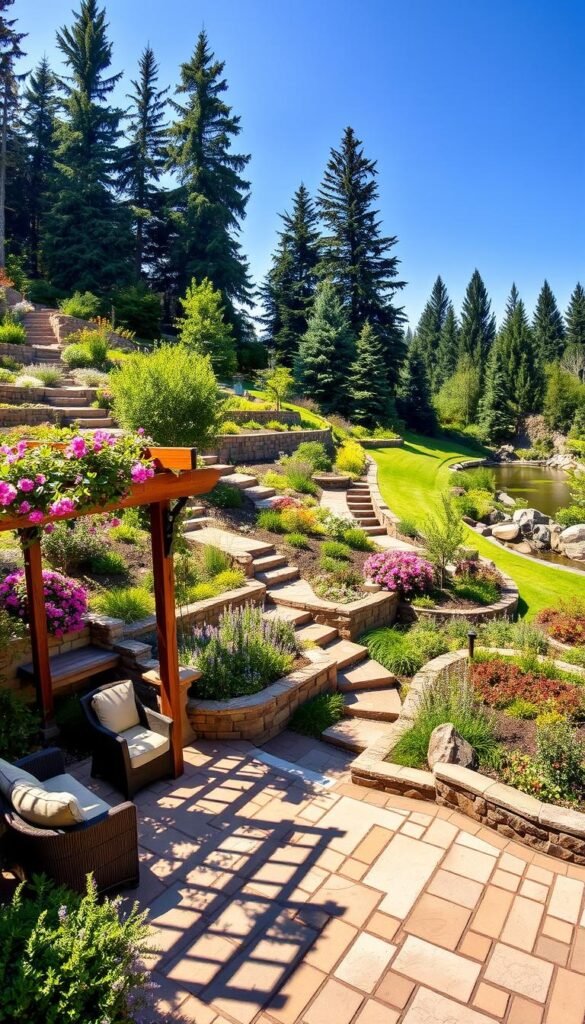
Elevation changes in your yard can become your greatest asset for crafting memorable outdoor experiences. By working with your slope’s natural curves, you’ll create functional areas that blend relaxation with breathtaking vistas.
Designing Inviting Seating and Patio Spaces
Start by identifying prime viewing spots. A tiered deck with built-in benches capitalizes on elevated sightlines while providing level outdoor living space. For slopes under 30 degrees, consider floating patios supported by gravel bases—they require minimal excavation and prevent soil disruption.
Multi-level designs connect spaces seamlessly. Pair upper deck seating with a lower fire pit area, linked by stone steps. One landscape architect suggests: “Curved pathways between zones create discovery moments while managing foot traffic.” Use materials like composite decking or stamped concrete for low-maintenance durability.
Key considerations for elevated structures:
- Helical piers or concrete footings for stable deck supports
- Railings with vertical balusters to maintain sightlines
- Integrated lighting along stairs and edges
Complete your design with weather-resistant cushions and native plant borders. These touches transform steep yards into cohesive extensions of your home, where every level offers new ways to unwind or entertain.
Addressing Challenges: Drainage, Erosion, and Maintenance
Maintaining a hillside landscape requires smart solutions that work with nature’s flow. Let’s explore how to protect your investment while keeping care routines manageable.
Water Management Made Simple
Start by redirecting runoff with French drains—trench systems filled with gravel that channel water away from problem areas. Pair these with drip irrigation lines that slowly deliver moisture to plant roots. This combo prevents soil erosion while cutting water waste by up to 70% compared to sprinklers.
Group plants by their hydration needs for efficiency. Place drought-resistant varieties like sedum at the slope’s peak, where water drains fastest. Thirstier species belong near the base, where moisture collects naturally. This strategy mirrors how container gardening solutions optimize limited spaces through smart zoning.
Living Anchors for Lasting Stability
Deep-rooted natives like prairie smoke or creeping juniper act as natural glue for your hillside. Their extensive root networks bind soil while foliage breaks rainfall’s impact. Space them 18-24 inches apart for quick coverage—most spread 2-3 feet annually.
Complement these green warriors with structural reinforcements. Bury landscape fabric beneath gravel paths to prevent washouts. For steep sections, install biodegradable coir netting that decomposes as plants establish. Remember: the best solutions combine smart engineering with nature’s resilience.

